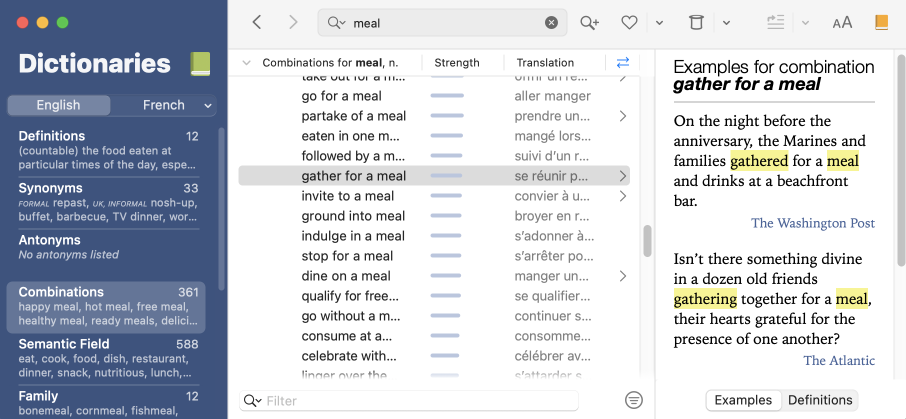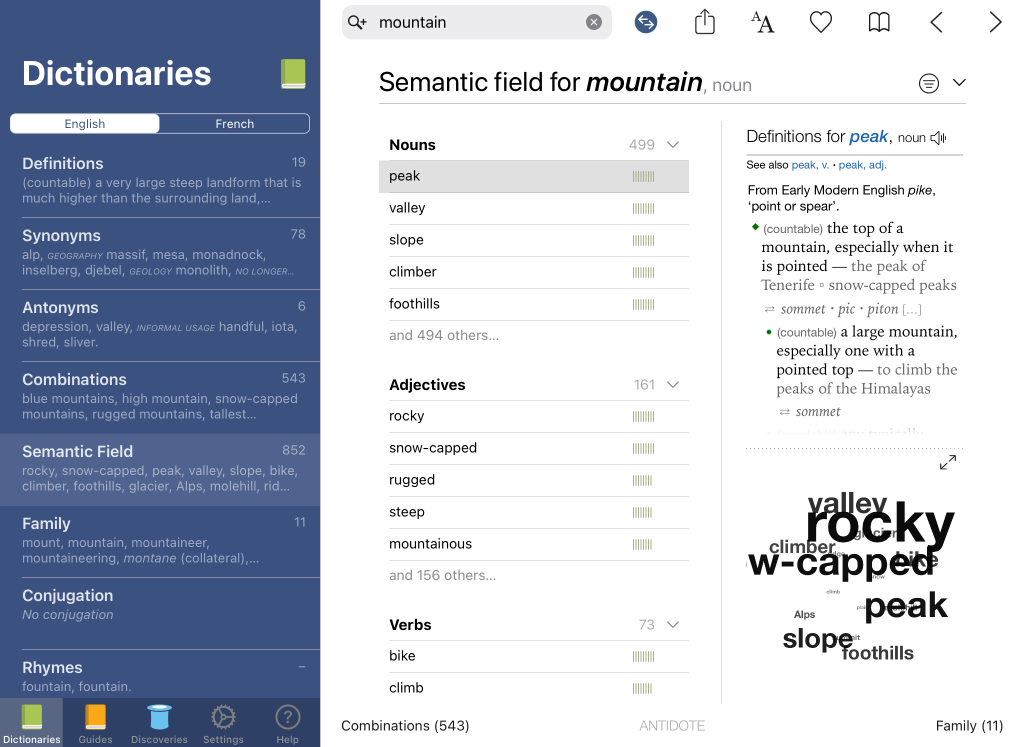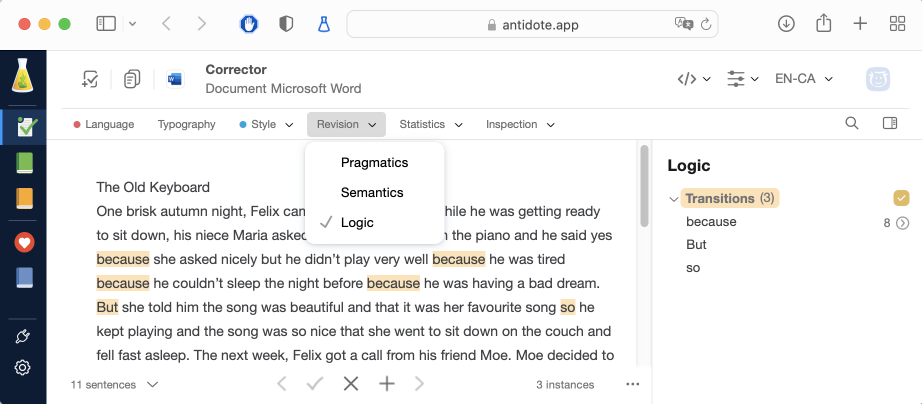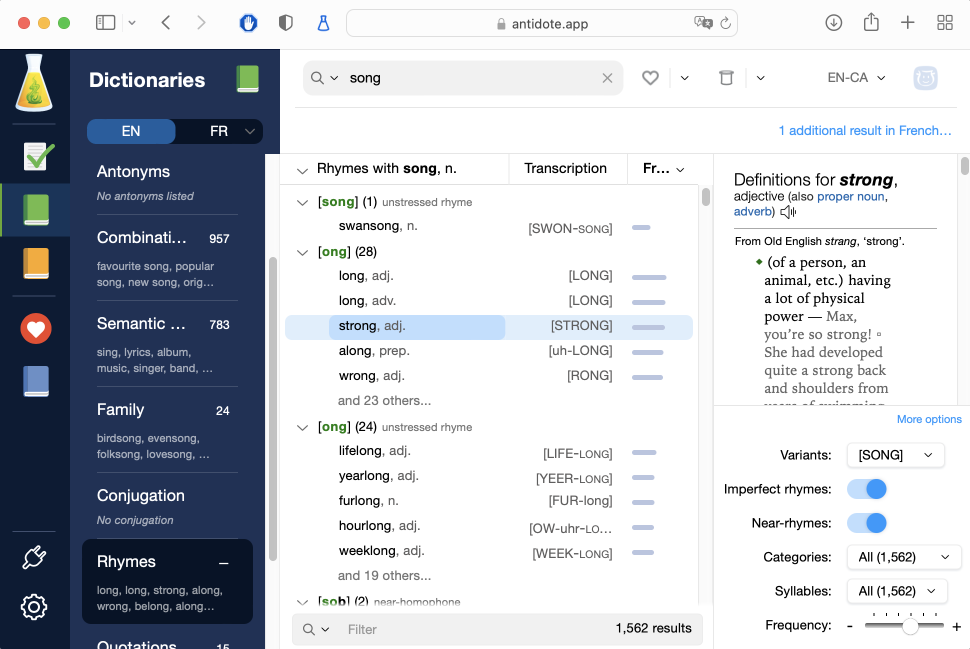Teaching English With Antidote: 5 Writing Exercises

Starting from the beginning of middle school or secondary school, using Antidote in English class can help students develop good writing and revision habits.
In the first article of this short series, we suggest several writing exercises, each associated with a specific feature in Antidote. Try them out in class and, after a few sessions, your students will be writing with more creativity, vividness and precision.
SERIES — Teaching English with Antidote
- 5 Writing Exercises
- 5 Features for Improving a Text
1. Writing with the dictionary of combinations
The dictionary of combinations shows words that are frequently used together. It is an excellent resource for enriching your students’ vocabulary. For example, invite them to write a text with the word meal, guest and taste using the entries found in the dictionary of combinations: The distinguished guests gathered for a meal of taste and refinement.
Antidote 11’s dictionary of combinations
If this exercise is repeated regularly, your students will make consulting dictionaries part of the writing process rather than the revision process.
Further reading: ▪ Find the Right Word, With Combinations ▪ The dictionary of combinations in the User Guide
2. Get inspired with semantic fields
Do your students groan at the thought of making a vocabulary list before they start writing? Transform this task into a fun, curiosity-piquing activity with Antidote’s dictionary of semantic fields. The sheer number of words available will surely give your students some good ideas! For example, instruct them to write a text with the semantic field of mountain, using at least one noun (ex: peak, valley, slope), one adjective (ex: rocky, snowcapped, rugged) and one verb (ex: climb, scale, hike) from the dictionary.
Antidote Mobile’s dictionary of semantic fields
To find inspiration, your students can have fun exploring the interactive sphere, which groups together the results of every grammatical category. The size of each word in the sphere indicates how strong its link is with the headword.
Further reading: ▪ The dictionary of semantic fields in the User Guide
3. Structure a text with transitions
Encourage your students to articulate their ideas more effectively using transitions, also called transitional words, linking words and connecting words. Antidote’s style guide suggests a wide range of logical, spatial and temporal links in its list of transitions. For example, ask your students to include at least one temporal connector (such as subsequently or in the meantime) and one contrast connector (such as however or nevertheless) in a short text.

Antidote Web’s style guide
Quickly find this list by typing “transitions” in the search field in the language guides, or access it directly on Antidote Web (subscription required).
Next, students can analyze their composition using the Logic filter of the Revision view, which highlights all the transitions in the text. This visual representation makes it easier to internalize the new grammar concepts discovered during the exercise.

Antidote Web’s Logic filter
Further reading: ▪ The logic filter in the User Guide
4. Keep verb tenses consistent with the tenses filter and the dictionary of conjugations
Help your students keep their verb tenses consistent by asking them, for example, to change a text from present tense to past tense. Tell them to do this exercise directly in the corrector, with the Tenses filter of the Statistics view. All verbs are highlighted and colour-coded by tense. This way, your students receive engaging feedback on the spot! If ever they have difficulty with a specific case, the dictionary of conjugations is a click away.
Further reading: ▪ The dictionary of conjugations in the User Guide ▪ The statistics filters in the User Guide
5. Write a poem with the dictionary of rhymes
The dictionary of rhymes, a new feature introduced in 2021, will inspire your students to write a sonnet, a song, or even a limerick! Not only does it feature lists of rhymes ordered by rhyme strength with the headword, but it also includes near-rhymes, that is to say terms with phonetic resemblances such as consonance or assonance. What a great opportunity to introduce your students to alliteration and help them perfect their rhymes: here is an administration of inspiration for witty ditties and strong songs!

Antidote Web’s dictionary of rhymes
To make this exercise even more engaging for your students, you could ask them to write an extra verse to their favourite song!
Further reading: ▪ Find the Right Word, With Rhymes ▪ The dictionary of rhymes in the User Guide
Gaining new writing habits takes time and discipline. Keeping this in mind, try to prioritize short and frequent exercises. Don’t be afraid to give your students the same exercise several times—try giving them the semantic field of cinema instead of mountain, for example.
Discover how more of Antidote’s features can be useful in class in the second article of this series, which explores ways to help your students revise their texts.



